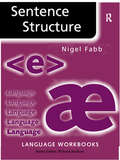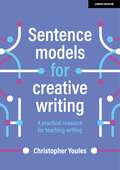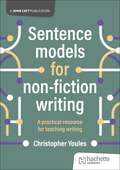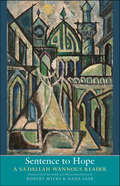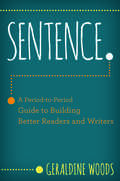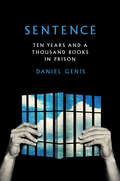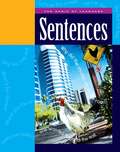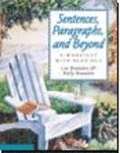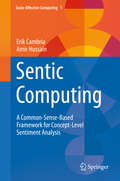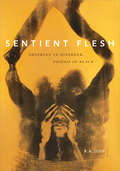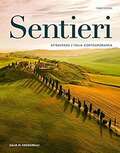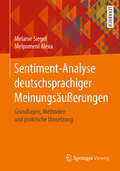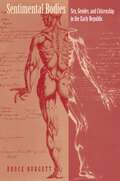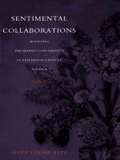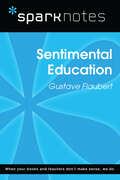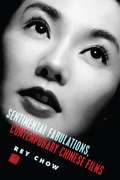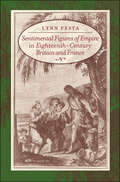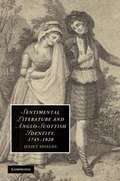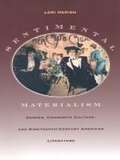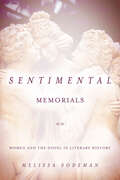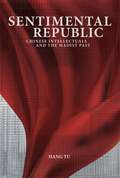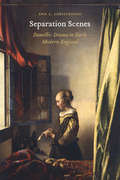- Table View
- List View
Sentence Structure (Language Workbooks)
by Nigel FabbSentence Structure: introduces the evidence for sentence structure and reveals its purpose is based on a problem-solving approach to language teaches the reader how to identify word classes, such as noun, preposition and demonstrative uses simple tree structures to analyse sentences contains numerous exercises to encourage practical skills of sentence analysis includes a database and exercises that compare the structure of English with other languages. The second edition of Sentence Structure has been revised and updated throughout and includes new material on tense, aspect, modality and the verb phrase, whilst the order of topics has been rearranged to improve clarity.
Sentence models for creative writing: A practical resource for teaching writing
by Christopher YoulesTeaching at sentence level is essential to improve writing. Knowing this, I desperately searched for a book packed full of sentence models that I could use to inspire my students. On discovering that no such book existed, I spent the next year poring over hundreds and hundreds of books to tap into the magic formula of what makes a great sentence. I sorted all these fantastic sentence structures into the domains through which we write stories: action, setting, character, feelings, physical effects, thoughts, the senses, and dialogue. This book contains hundreds of those sentence models. Each chapter also contains practical advice on effectively teaching the different aspects of story writing. The sentences can be used as creative writing exercises, inspiration for your exemplary text, or ideas for writing lessons. This book will reveal the magic formula behind great writing and give you a secret window into how this writing is created.
Sentence models for creative writing: A practical resource for teaching writing
by Christopher YoulesTeaching at sentence level is essential to improve writing. Knowing this, I desperately searched for a book packed full of sentence models that I could use to inspire my students. On discovering that no such book existed, I spent the next year poring over hundreds and hundreds of books to tap into the magic formula of what makes a great sentence. I sorted all these fantastic sentence structures into the domains through which we write stories: action, setting, character, feelings, physical effects, thoughts, the senses, and dialogue. This book contains hundreds of those sentence models. Each chapter also contains practical advice on effectively teaching the different aspects of story writing. The sentences can be used as creative writing exercises, inspiration for your exemplary text, or ideas for writing lessons. This book will reveal the magic formula behind great writing and give you a secret window into how this writing is created.
Sentence models for non-fiction writing
by Christopher YoulesAre your students struggling to write clear, concise, and engaging non-fiction prose? Offering a wealth of sentence models and advice, this practical book provides everything you need to help students of all ages to craft compelling sentences and learn the essential elements of effective non-fiction writing.The comprehensive coverage includes: selecting engaging topics for non-fiction writing; planning a structure; and tailoring the style to the audience. Improve your students' clarity and coherence and enable them to master the art of writing in different non-fiction genres, including informative writing and persuasive writing.
Sentence models for non-fiction writing
by Christopher YoulesAre your students struggling to write clear, concise, and engaging non-fiction prose? Offering a wealth of sentence models and advice, this practical book provides everything you need to help students of all ages to craft compelling sentences and learn the essential elements of effective non-fiction writing.The comprehensive coverage includes: selecting engaging topics for non-fiction writing; planning a structure; and tailoring the style to the audience. Improve your students' clarity and coherence and enable them to master the art of writing in different non-fiction genres, including informative writing and persuasive writing.
Sentence to Hope: A Sa'dallah Wannous Reader (The Margellos World Republic of Letters)
by Sa'dallah WannousThe first major English‑language collection of plays and essays by Syrian playwright Sa'dallah Wannous Sa'dallah Wannous is acknowledged to be one of the Arab world’s most significant playwrights, writers, and intellectuals of the twentieth century. This is the first major English‑language collection that brings together his most significant plays and essays. Selections include the groundbreaking 1969 play An Evening’s Entertainment for the Fifth of June, a scathing indictment of the duplicity of Arab leaders during the 1967 War, as well as Wannous’s most celebrated play, Rituals of Signs and Transformations, a bold treatment of homosexuality, prostitution, clerical corruption, and the quest for female liberation. In addition to his work as a playwright, Wannous, like Brecht, was an astute theatrical and cultural critic, and his essays, some of which are included here, offer shrewd diagnoses of the ills of Arab society and the essential role of theater in ameliorating them.
Sentence.: A Period To Period Guide To Building Better Readers And Writers
by Geraldine WoodsSometimes it’s better to start small, with a sentence. Every English teacher has experienced it: students staring at an empty page, seemingly paralyzed by a writing assignment. When this happens, it may be time to back off from the Big Idea approach to the art of reading and writing, and zero in on a single sentence. In this book, a master teacher offers a complete guide to a sentence-level approach. Helping students recognize the techniques that make sentences great is the first step, and there are plenty of examples here from YA novels, TV shows, and song lyrics as well as the novels, poetry, and nonfiction pieces that form the canon of middle and high school reading lists. Lesson plans include activities to introduce the featured element of style; questions to guide students in their analysis; and writing prompts and activities to spark students’ interest and creativity. With this Little-to-Big strategy, students move quickly from analysis of the words between two periods to the universe of ideas of which that sentence is a part. They may even be eager to write their own
Sentence: Ten Years and a Thousand Books in Prison
by Daniel GenisA memoir of a decade in prison by a well-educated young addict known as the "Apologetic Bandit"In 2003 Daniel Genis, the son of a famous Soviet émigré writer, broadcaster, and culture critic, was fresh out of NYU when he faced a serious heroin addiction that led him into debt and ultimately crime. After he was arrested for robbing people at knifepoint, he was nicknamed the &“apologetic bandit&” in the press, given his habit of expressing his regret to his victims as he took their cash. He was sentenced to twelve years—ten with good behavior, a decade he survived by reading 1,046 books, taking up weightlifting, having philosophical discussions with his fellow inmates, working at a series of prison jobs, and in general observing an existence for which nothing in his life had prepared him. Genis describes in unsparing and vivid detail the realities of daily life in the New York penal system. In his journey from Rikers Island and through a series of upstate institutions he encounters violence on an almost daily basis, while learning about the social strata of gangs, the &“court&” system that sets geographic boundaries in prison yards, how sex was obtained, the workings of the black market in drugs and more practical goods, the inventiveness required for everyday tasks such as cooking, and how debilitating solitary confinement actually is—all while trying to preserve his relationship with his recently married wife. Written with empathy and wit, Sentence is a strikingly powerful memoir of the brutalities of prison and how one man survived then, leaving its walls with this book inside him, &“one made of pain and fear and laughter and lots of other books.&”
Sentences (The Magic of Language)
by Ann HeinrichsSentences can be long and short, simple and complex. Regardless of what form they take, they are crucial to reading comprehension. Kid-friendly text and helpful exercises illustrate the different elements that comprise a sentence.
Sentences, Paragraphs, and Beyond: A Worktext with Readings
by Kelly Brandon Lee BrandonFrom the book: The text's three parts and the appendixes cover the full array of topics needed for developmental writing. Part One: Writing Sentences includes parts of sentence structure, phrases and clauses, kinds of sentences, sentence combining, sentence problems, pronoun use, modifiers, punctuation, and spelling. Part Two: Writing Paragraphs and Beyond covers the writing process with instructions, examples, demonstrations, and exercises in freewriting, brainstorming, clustering, topic sentence writing, outlining, revising, and editing. Part Three: Connecting Reading and Writing provides guidance in reading critically and writing summaries; practicing reading-related responses; and recognizing patterns such as process, cause and effect, and exemplification. Reading selections by students and professional writers are dually grouped by pattern and theme. Appendixes cover parts of speech, taking tests, writing a letter of application and a resume, and a guide for ESL students.
Sentic Computing
by Amir Hussain Erik CambriaIn this book common sense computing techniques are further developed and applied to bridge the semantic gap between word-level natural language data and the concept-level opinions conveyed by these. In particular, the ensemble application of graph mining and multi-dimensionality reduction techniques is exploited on two common sense knowledge bases to develop a novel intelligent engine for open-domain opinion mining and sentiment analysis. The proposed approach, termed sentic computing, performs a clause-level semantic analysis of text, which allows the inference of both the conceptual and emotional information associated with natural language opinions and, hence, a more efficient passage from (unstructured) textual information to (structured) machine-processable data.
Sentient Flesh: Thinking in Disorder, Poiesis in Black (Black Outdoors: Innovations in the Poetics of Study)
by R. A. JudyIn Sentient Flesh R. A. Judy takes up freedman Tom Windham’s 1937 remark “we should have our liberty 'cause . . . us is human flesh" as a point of departure for an extended meditation on questions of the human, epistemology, and the historical ways in which the black being is understood. Drawing on numerous fields, from literary theory and musicology, to political theory and phenomenology, as well as Greek and Arabic philosophy, Judy engages literary texts and performative practices such as music and dance that express knowledge and conceptions of humanity appositional to those grounding modern racialized capitalism. Operating as critiques of Western humanism, these practices and modes of being-in-the-world—which he theorizes as “thinking in disorder,” or “poiēsis in black”—foreground the irreducible concomitance of flesh, thinking, and personhood. As Judy demonstrates, recognizing this concomitance is central to finding a way past the destructive force of ontology that still holds us in thrall. Erudite and capacious, Sentient Flesh offers a major intervention in the black study of life.
Sentiment-Analyse deutschsprachiger Meinungsäußerungen: Grundlagen, Methoden und praktische Umsetzung
by Melanie Siegel Melpomeni AlexaDer Zugang zu Information ist durch das Internet erheblich verändert und erleichtert worden. Gleichzeitig gibt es seit dem Web 2.0 die Möglichkeit für alle Internet-Nutzer, selbst Inhalte beizusteuern, indem sie in Foren schreiben, oder Twitter, Xing, LinkedIn, Facebook oder andere soziale Medien nutzen und auf veröffentliche Posts z. B. durch Kommentare reagieren. Diese Fülle an Informationen und Meinungen ist ein wertvoller und in der Regel sehr großer Datenschatz, den man nur mit automatischen Verfahren sinnvoll nutzen kann.Die automatische Analyse von Meinungsäußerungen gehört in die Anwendungsbereiche Informationsextraktion und Inhaltsanalyse sowie Text Mining. Aus Texten von Internet-Nutzern werden Informationen extrahiert und analysiert, wie sie sich zu bestimmten Themen, Produkten oder Ereignissen äußern.Dieses Buch gibt eine systematische Einführung in Methoden der automatischen Analyse von Meinungsäußerungen und zeigt die Anwendung der beschriebenen Methoden in Programmierübungen. Der Fokus liegt dabei auf deutschsprachige Daten, also auf linguistischen Ressourcen sowie Methoden zur automatischen Analyse für die deutsche Sprache. Viele Übungsaufgaben sowie in Python implementierte Programmierbeispiele und -aufgaben machen das Buch zum optimalen Begleiter für Studium und Selbststudium.
Sentimental Bodies: Sex, Gender, and Citizenship in the Early Republic
by Bruce BurgettSentimentalism, sex, the construction of the modern body, and the origins of American liberalism all come under scrutiny in this rich discussion of political life in the early republic. Here Bruce Burgett enters into debates over the "public sphere," a concept introduced by Jurgen Habermas that has led theorists to grapple with such polarities as public and private, polity and personality, citizenship and subjection. With the literary public sphere as his primary focus, Burgett sets out to challenge the Enlightenment opposition of reason and sentiment as the fundamental grid for understanding American political culture. Drawing on texts ranging from George Washington's "Farewell Address" and Charles Brockden Brown's Clara Howard to Hannah Foster's The Coquette and Harriet Jacobs's Incidents in the Life of a Slave Girl, Burgett shows that the sentimental literary culture of the period relied on readers' affective, passionate, and embodied responses to fictive characters and situations in order to produce political effects. As such, sentimentalism located readers' bodies both as prepolitical sources of personal authenticity and as public sites of political contestation. Going beyond an account of the public sphere as a realm to which only some have full access, Burgett reveals that the formation of the body and sexual subjectivity is crucial to the very construction of that sphere. By exploring and destabilizing the longstanding distinction between public and private life, this book raises questions central to any democratic political culture.
Sentimental Collaborations: Mourning and Middle-Class Identity in Nineteenth-Century America
by Mary Louise KeteDuring the 1992 Democratic Convention and again while delivering Harvard University's commencement address two years later, Vice President Al Gore shared with his audience a story that showed the effect of sentiment in his life. In telling how an accident involving his son had provided him with a revelation concerning the compassion of others, Gore effectively reconstructed himself as a typical, middle-class American for whom sympathy can lead to salvation. This contemporary reiteration of mid-nineteenth-century American sentimental discourse proves to be a fruitful point of departure for Mary Louise Kete's argument that sentimentality has been an important and recurring form of cultural narrative that has helped to shape middle-class American life. Many scholars have written about the sentimental novel as a primarily female genre and have stressed its negative ideological aspects. Kete finds that in fact many men--from writers to politicians--participated in nineteenth-century sentimental culture. Importantly, she also recovers the utopian dimension of the phenomenon, arguing that literary sentimentality, specifically in the form of poetry, is the written trace of a broad cultural discourse that Kete calls "sentimental collaboration"--an exchange of sympathy in the form of gifts that establishes common cultural or intellectual ground. Kete reads the work of Ralph Waldo Emerson, Henry Wadsworth Longfellow, Mark Twain, Harriet Beecher Stowe, and Lydia Huntley Sigourney with an eye toward the deployment of sentimentality for the creation of Americanism, as well as for political and abolitionist ends. Finally, she locates the origins of sentimental collaboration in the activities of ordinary people who participated in mourning rituals--writing poetry, condolence letters, or epitaphs--to ease their personal grief. Sentimental Collaborations significantly advances prevailing scholarship on Romanticism, antebellum culture, and the formation of the American middle class. It will be of interest to scholars of American studies, American literature, cultural studies, and women's studies.
Sentimental Education (SparkNotes Literature Guide Series)
by SparkNotesSentimental Education (SparkNotes Literature Guide) by Gustave Flaubert Making the reading experience fun!Created by Harvard students for students everywhere, SparkNotes is a new breed of study guide: smarter, better, faster. Geared to what today's students need to know, SparkNotes provide:Chapter-by-chapter analysisExplanations of key themes, motifs, and symbolsA review quiz and essay topicsLively and accessible, these guides are perfect for late-night studying and writing papers.
Sentimental Fabulations, Contemporary Chinese Films: Attachment in the Age of Global Visibility (Film and Culture Series)
by Rey ChowWhat is the sentimental? How can we understand it by way of the visual and narrative modes of signification specific to cinema and through the manners of social interaction and collective imagining specific to a particular culture in transition? What can the sentimental tell us about the precarious foundations of human coexistence in this age of globalization? Rey Chow explores these questions through nine contemporary Chinese directors (Chen Kaige, Wong Kar-wai, Zhang Yimou, Ann Hui, Peter Chan, Wayne Wang, Ang Lee, Li Yang, and Tsai Ming-liang) whose accomplishments have become historic events in world cinema. Approaching their works from multiple perspectives, including the question of origins, nostalgia, the everyday, feminine "psychic interiority," commodification, biopolitics, migration, education, homosexuality, kinship, and incest, and concluding with an account of the Chinese films' epistemic affinity with the Hollywood blockbuster Brokeback Mountain, Chow proposes that the sentimental is a discursive constellation traversing affect, time, identity, and social mores, a constellation whose contours tends to morph under different historical circumstances and in different genres and media. In contemporary Chinese films, she argues, the sentimental consistently takes the form not of revolution but of compromise, not of radical departure but of moderation, endurance, and accommodation. By naming these films sentimental fabulations-screen artifacts of cultural becoming with irreducible aesthetic, conceptual, and speculative logics of their own-Chow presents Chinese cinema first and foremost as an invitation to the pleasures and challenges of critical thinking.
Sentimental Figures of Empire in Eighteenth-Century Britain and France
by Lynn FestaIn this ambitious and original study, Lynn Festa examines how and why sentimental fiction became one of the primary ways of representing British and French relations with colonial populations in the eighteenth century. Drawing from novels, poetry, travel narratives, commerce manuals, and philosophical writings, Festa shows how sentimentality shaped communal and personal assertions of identity in an age of empire.Read in isolation, sentimental texts can be made to tell a simple story about the emergence of the modern psychological self. Placed in conversation with empire, however, sentimentality invites both psychological and cultural readings of the encounter between self and other. Sentimental texts, Festa claims, enabled readers to create powerful imagined relations to distant people. Yet these emotional bonds simultaneously threatened the boundaries between self and other, civilized and savage, colonizer and colonized. Festa argues that sentimental tropes and figures allowed readers to feel for others, while maintaining the particularity of the individual self. Sentimental identification thus operated as a form of differentiation as well as consolidation.Festa contends that global reach increasingly outstripped imaginative grasp during this era. Sentimentality became an important tool for writers on empire, allowing conquest to be portrayed as commerce and scenes of violence and exploitation to be converted into displays of benevolence and pity. Above all, sentimental texts used emotion as an important form of social and cultural distinction, as the attribution of sentience and feeling helped to define who would be recognized as human.
Sentimental Literature and Anglo-Scottish Identity, 1745-1820
by Juliet ShieldsWhat did it mean to be British, and more specifically to feel British, in the century following the parliamentary union of Scotland and England? Juliet Shields departs from recent accounts of the Romantic emergence of nationalism by recovering the terms in which eighteenth- and early nineteenth-century writers understood nationhood. She argues that in the wake of the turmoil surrounding the Union, Scottish writers appealed to sentiment, or refined feeling, to imagine the nation as a community. They sought to transform a Great Britain united by political and economic interests into one united by shared sympathies, even while they used the gendered and racial connotations of sentiment to differentiate sharply between Scottish, English, and British identities. By moving Scotland from the margins to the center of literary history, the book explores how sentiment shaped both the development of British identity and the literature within which writers responded creatively to the idea of nationhood.
Sentimental Materialism: Gender, Commodity Culture, and Nineteenth-Century American Literature
by Lori MerishIn Sentimental Materialism Lori Merish considers the intricate relationship between consumption and womanhood in the late eighteenth and nineteenth centuries. Taking as her starting point a diversity of cultural artifacts--from domestic fiction and philosophical treatises to advice literature and cigars--Merish explores the symbolic functions they served and finds that consumption evolved into a form of personal expressiveness that indicated not only a woman's wealth and taste but also her race, class, morality, and civic values. The discursive production of this new subjectivity--the feminine consumer--was remarkably influential, helping to shape American capitalism, culture, and nation building.The phenomenon of female consumption was capitalism's complement to male production: It created what Merish calls the "Other Protestant Ethic,"a feminine and sentimental counterpart to Max Weber's ethic of hard work, economic rationality, and self-control. In addition, driven by the culture's effort to civilize the "cannibalistic" practices of ethnic, class, and national otherness, appropriate female consumerism, marked by taste and refinement, identified certain women and their families as proper citizens of the United States. The public nature of consumption, however, had curiously conflicting effects: While the achievement of cultured material circumstances facilitated women's civic agency, it also reinforced stereotypes of domestic womanhood.Sentimental Materialism's inquiry into middle-class consumption and accompanying ideals of womanhood will appeal to readers in a variety of disciplines, including American studies, cultural studies, feminist theory, and cultural history.
Sentimental Memorials: Women and the Novel in Literary History
by Melissa SodemanDuring the later eighteenth century, changes in the meaning and status of literature left popular sentimental novels stranded on the margins of literary history. While critics no longer dismiss or ignore these works, recent reassessments have emphasized their interventions in various political and cultural debates rather than their literary significance. Sentimental Memorials, by contrast, argues that sentimental novels gave the women who wrote them a means of clarifying, protesting, and finally memorializing the historical conditions under which they wrote. As women writers successfully navigated the professional marketplace but struggled to position their works among more lasting literary monuments, their novels reflect on what the elevation of literature would mean for women's literary reputations. Drawing together the history of the novel, women's literary history, and book history, Melissa Sodeman revisits the critical frameworks through which we have understood the history of literature. Novels by Sophia Lee, Ann Radcliffe, Charlotte Smith, and Mary Robinson, she argues, offer ways of rethinking some of the signal literary developments of this period, from emerging notions of genius and originality to the rise of an English canon. And in Sodeman's analysis, novels long seen as insufficiently literary acquire formal and self-historicizing importance.
Sentimental Opera
by Stefano CastelvecchiSentimental Opera is a study of the relationship between opera and two major phenomena of eighteenth-century European culture - the cult of sensibility and the emergence of bourgeois drama. A thorough examination of social and cultural contexts helps to explain the success of operas such as Paisiello's Nina as well as the extreme emotional reactions of their audiences. Like their counterparts in drama, literature and painting, these works brought to the fore serious contemporary problems including the widespread execution of deserters, the treatment of the insane, and anxieties relative to social and familial roles. They also developed a specifically operatic version of the dominant language of sensibility. This wide-ranging study involves such major cultural figures as Goldoni, Diderot and Mozart, while refining our understanding of the theatrical genre system of their time.
Sentimental Republic: Chinese Intellectuals and the Maoist Past (Harvard Contemporary China Series #21)
by Hang TuHow does emotion shape the landscape of public intellectual debate? In Sentimental Republic, Hang Tu proposes emotion as a new critical framework to approach a post-Mao cultural controversy. As it entered a period of market reform, China did not turn away from revolutionary sentiments. Rather, the post-Mao period experienced a surge of emotionally charged debates about red legacies, ranging from the anguished denunciations of Maoist violence to the elegiac remembrances of socialist egalitarianism.Sentimental Republic chronicles forty years (1978–2018) of bitter cultural wars about the Maoist past. It analyzes how the four major intellectual clusters in contemporary China—liberals, the left, cultural conservatives, and nationalists—debated Mao’s revolutionary legacies in light of the postsocialist transition. Should the Chinese condemn revolutionary violence and “bid farewell to socialism”? Or would a return to revolution foster alternative visions of China’s future path? Tu probes the nexus of literature, thought, and memory, bringing to light the dynamic moral sentiments and emotional excess at work in these post-Mao ideological contentions. By analyzing how rival intellectual camps stirred up melancholy, guilt, anger, and resentment, Tu argues that the polemics surrounding the country’s past cannot be properly understood without reading the emotional trajectories of the post-Mao intelligentsia.
Separation Scenes: Domestic Drama in Early Modern England (Early Modern Cultural Studies)
by Ann C. ChristensenThis analysis of five exemplary domestic plays—the anonymous Arden of Faversham and A Warning for Fair Women (1590s), Thomas Heywood’s A Woman Killed with Kindness (1607), Thomas Middleton’s Women Beware Women (ca. 1613), and Walter Mountfort’s The Launching of the Mary, or The Seaman’s Honest Wife (1632)—offers a new approach to the emerging ideology of the private and public, or what Ann C. Christensen terms “the tragedy of the separate spheres.” Feminist scholarship has identified the fruitful gaps between theories and practices of household government in early modern Europe, while work on the global Renaissance attends to commercial expansion, cross-cultural encounters, and colonial settlements. Separation Scenes brings these critical concerns together to expose the intimate and disruptive relationships between the domestic culture and business culture of early modern England. Separation Scenes argues that domestic plays make the absence of husbands for business the subject of tragedy by focusing not on where men traveled but on whom and what they left behind. Elements that critics have rightly associated with domestic tragedy—adultery, sensational murders, and the lavishly articulated operations of domestic life—define this world, which, Christensen argues, was equally shaped by the absence of husbands. Her interpretations of these domestic plays invite us to historicize and further complicate the seemingly universal binary between a feminine “private sphere” and a masculine “public sphere.” Separation Scenes demonstrates how domestic drama played an active, dynamic, and critical role in deliberating the costs of commercial travel as it disrupted domestic conduct and prompted realignments within the home.
